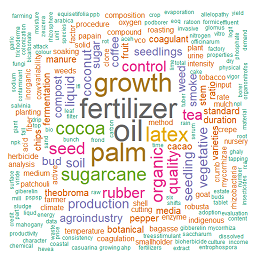Respons Pertumbuhan Vegetatif Tanaman Tebu terhadap Konsentrasi Zat Pengatur Tumbuh pada Berbagai Bagian Asal Bibit
DOI:
https://doi.org/10.25181/jaip.v9i1.1910Keywords:
bud chips, part plant, plant growth regulator, sugarcaneAbstract
Increasing sugarcane productivity can be done by providing good quality seedlings. The research objective was to study plant growth regulator concentration and part of seedling origin in sugarcane seedlings. This study was conducted on Pujodadi Village, Trimurjo, Central Lampung from September to December 2020. The study used a factorial randomized block design with two factors and three replications. The first factor is concentration of plant growth regulator which consists of 5 levels: Z0 (0 ml.l-1), Z1 (3.5 ml.l-1), Z2 (7 ml.l-1), Z3 (10.5 ml.l-1) and Z4 (14 ml.l-1). The second factor is the origin of the seedling consists of three parts: P1 (upper stem), P2 (middle stem), and P3 (bottom stem). The results showed that the plant growth regulator concentration significantly increased the percentage of growth and 50% of the seedlings sprouted. The seedling origin of the upper stem showed the best growth compared to the middle and bottom stem. There was no interaction between plant growth regulator concentration and the part of seedling origin on sugarcane vegetative growth.Downloads
References
Agathokleous, E., Belz, R. G., Kitao, M., Koike, T., & Calabrese, E. J. (2019). Does the root to shoot ratio show a hormetic response to stress ? An ecological and environmental perspective. Journal of Forestry Research, 30(5), 1569–1580. https://doi.org/10.1007/s11676-018-0863-7
Alamilla-Magana, J. C., Carrillo-Avila, E., Obrador-Olan, J. J., Landeros-Sancez, C., Vera-Lopez, J., & Juarez-Lopez, J. F. (2016). Soil moisture tension effect on sugar cane growth and yield. Agricultural Water Management, 177, 264–273. https://doi.org/10.1016/j.agwat.2016.08.004
Allaby, M. (2006). A Dictionary of Plant Sciences (2nd ed.). https://doi.org/10.1093/acref/9780198608912.001.0001
Alpriyan, D., & Karyawati, S. (2018). Pengaruh Konsentrasi dan Lama Perendaman Hormon Auksin Pada Bibit Tebu (Saccharum officinarum L.). Jurnal Pertanian Terapan, 6(7), 1354–1362.
Álvarez-Flórez, F., López-Cristoffanini, C., Jáuregui, O., Melgarejo, L. M., & López-Carbonell, M. (2017). Plant Physiology and Biochemistry Changes in ABA , IAA and JA levels during calyx , fruit and leaves development in cape gooseberry plants ( Physalis peruviana L .). Plant Physiology and Biochemistry, 115, 174–182. https://doi.org/10.1016/j.plaphy.2017.03.024
Anindita, D. C., Winarsih, S., Sebayang, H, T., & Yudo, S. (2017). Pertumbuhan Bibit Mata Tunas Yang Berasal dari Nomor Mata Tunas Berbeda Pada Tanaman Tebu (Saccaharum Officinarum L.) Varietas Bululawang dan Ps862. Jurnal Produksi Tanaman, 5(3), 451–459.
Banful, B. K., & Attivor, D. (2017). Growth and yield response of two hybrid rice cultivars to ATONIK plant growth regulator in a Tropical environment. Environment, Eart and Ecology, 1(1), 33–45. https://doi.org/10.24051/eee/69223
Bari, R., & Jones, J. D. G. (2009). Role of plant hormones in plant defence responses. Plant. Mol. Biol, 69, 473–488. https://doi.org/10.1007/s11103-008-9435-0
Dijkstra, P., Chuckran, P. F., & Hungate, B. A. (2020). What is respiration - response to glucose addition , presence of plant roots and di erences across biomes. EGU General Assembly Conference Abstracts, 12072.
Durroh, B. (2019). Efektivitas Air Kelapa Muda Sebagai Zpt dan Pupukanorganik dalam Merangsang Pertumbuhan Bibit Stek Tebu G3. BERNAS Agricultural Research Journal, 15(1), 54–57.
Galal, M. O. A. (2018). A new technique for planting sugarcane in Egypt. IIOABJ, 7(4), 15–21.
Jain, R., & Shrivastava, S. S. A. K. (2010). Sugarcane bud chips : A promising seed material. 12(1), 67–69.
Kociraa, A., Kocira, S., Swieca, M., Złotekc, U., Jakubczykc, A., & Krzysztof, K. (2017). Effect of foliar application of a nitrophenolate – based biostimulant on the yield and quality of two bean cultivars Scientia Horticulturae Effect of foliar application of a nitrophenolate – based biostimulant on the yield and quality of two bean cultivar. Scientia Horticulturae, 214, 76–82. https://doi.org/10.1016/j.scienta.2016.11.021
Mašková, T., & Herben, T. (2018). Root : shoot ratio in developing seedlings : How seedlings change their allocation in response to seed mass and ambient nutrient supply. Ecology and Evolution, 8(14), 7143–7150. https://doi.org/10.1002/ece3.4238
Mauri, R., Coehho, R. D., Junior, E. F. ., Barbosa, F. D. ., & Leal, D. P. . (2017). Water relations at the initial sugarcane growth phase under variable water deficit. Eng. Agríc., Jaboticabal, 37(2), 268–276.
Musa, Y., Ridwan, I., Ponto, H., Ala, A., Farid, M., Widiayani, N., & Yayank, A. . (2020). Application of Arbuscular Mycorrhizal Fungus (AMF) improves the growth of single-bud sugarcane (Saccharum officinarum L.) seedlings from different bud location. IOP Conference Series: Earth and Environmental Science, 1–8. https://doi.org/10.1088/1755-1315/486/1/012122
Nguyen, C. T., Dang, L. H., Nguyen, D. T., & Tran, K. P. (2019). Effect of GA3 and Gly Plant Growth Regulators on Productivity and Sugar Content of Sugarcane. Agriculture, 9(7), 1–13.
Pamungkas, S. S. ., & Puspitasari, R. (2018). Pemanfaatan Bawang Merah (Allium cepa L.) Sebagai Zat Pengatur Tumbuh Alami terhadap Pertumbuhan Bud Chip Tebu pada Berbagai Tingkat Waktu Rendaman. BIOFARM, 14(2), 41–47.
Patel, D., & Chaudhary, M. P. (2018). Influence of plant growth regulators on growth , yield and quality of sugarcane under south Gujarat. Journal of Pharmacognosy and Phytochemistry, 95–97.
Putri, A. D., & Islami, T. (2013). Pengaruh Komposisi Media Tanam Pada Teknik Bud Chip Tiga Varietas Tebu (Saccharum officinarum L.). Jurnal Produksi Tanaman, 1(1), 16–23.
Rachmawati, D. L., Roviq, M., & Islami, T. (2017). Komposisi Atonik dan Air Kelapa Pada Pertumbuhan Bud Chip S Tebu (Saccharum officinarum L.). Jurnal Produksi Tanaman, 5(5), 851–859.
Samant, T. K. (2017). Bud chip method : A potential technology for sugarcane ( Saccharum officinarum ) cultivation. Journal of Medicinal Plants Studies, 5(3), 355–357.
Siddiqui, H., Sami, F., & Hayat, S. (2020). Glucose : Sweet or bitter effects in plants-a review on current and future perspective. Carbohydrate Research, 487, 107884. https://doi.org/https://doi.org/10.1016/j.carres.2019.107884
Siswoyo, T. A., Oktavianawati, I., Murdiyanto, U., & Sugiharto, B. (2007). Changes of Sucrose Content And Invertase Activity During Sugarcane Stem Storage. Indonesian Journal of Agricultural Science, 8(2), 75–81.
Sunarlim, N., Zam, S. ., & Purwanto, J. (2012). Pelukaan Benih dan Perendaman dengan Atonik Pada Perkecambahan Benih dan Pertumbuhan Tanaman Semangka Non Biji (Citrullus vulgaris Schard L .). Jurnal Agroteknologi, 2(2), 29–32.
Zainuddin, A., & Wibowo, R. (2017). Efisiensi Teknis Usahatani Tebu dengan Metode Bud Chip di Wilayah Kerja PTPN X. Seminar Nasional Pembangunan Pertanian II: Arah Dan Tantangan Pembangunan Pertanian Dalam Era SDG’s, 84–88.
Downloads
Published
How to Cite
Issue
Section
License
Copyright (c) 2021 Oki Puspita Wardani, Priyadi Priyadi, Yatmin Yatmin

This work is licensed under a Creative Commons Attribution-ShareAlike 4.0 International License.
Authors who publish with Jurnal Agro Industri Perkebunan agree to the following terms:
Authors retain copyright and grant the Jurnal Agro Industri Perkebunan right of first publication with the work simultaneously licensed under a Creative Commons Attribution License (CC BY-SA 4.0) that allows others to share (copy and redistribute the material in any medium or format) and adapt (remix, transform, and build upon the material for any purpose, even commercially) with an acknowledgment of the work's authorship and initial publication in Jurnal Agro Industri Perkebunan.
Authors are able to enter into separate, additional contractual arrangements for the non-exclusive distribution of the journal's published version of the work (e.g., post it to an institutional repository or publish it in a book), with an acknowledgment of its initial publication in Jurnal Agro Industri Perkebunan. Authors are permitted and encouraged to post their work online (e.g., in institutional repositories or on their website) prior to and during the submission process, as it can lead to productive exchanges, as well as earlier and greater citation of published work.


























